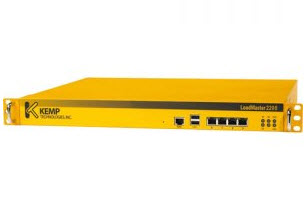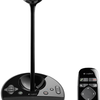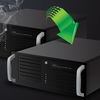 KEMP Technologies, a 10 year old company today announced the first server load balancing appliance, specifically designed for Microsoft Exchange 2010. The new KEMP’s LoadMaster Exchange (LM-Exchange) comes pre-configured and ready to deploy for instant redundancy and high availability for the enterprise's critical Exchange 2010 services. The new LM-Exchange server is a load balancing and application delivery appliance designed to address high-availability and scalability demands of Microsoft Exchange 2010 deployments for businesses up to 250 users.
KEMP Technologies, a 10 year old company today announced the first server load balancing appliance, specifically designed for Microsoft Exchange 2010. The new KEMP’s LoadMaster Exchange (LM-Exchange) comes pre-configured and ready to deploy for instant redundancy and high availability for the enterprise's critical Exchange 2010 services. The new LM-Exchange server is a load balancing and application delivery appliance designed to address high-availability and scalability demands of Microsoft Exchange 2010 deployments for businesses up to 250 users.
While all of KEMP’s server load balancing and application delivery controller (ADCs) products currently support and are approved by Microsoft’s Exchange Server 2010 qualification program for hardware and software load balancers, the LM-Exchange is the first product of its kind that was specifically designed and purpose-built for Microsoft’s Exchange 2010.
I spoke with KEMP Technologies’ co-founder and VP of product management Peter Melerud about this new offering.
Peter explained, "More than a year ago Microsoft released Exchange 2010 which is substantially different architecturally from previous versions. What they've done is separated some of the key roles, like CAS, hub, transport, and edge roles. Microsoft has always had a load balancing product called NLB, which is not quite up to the standards of purpose-built appliances. But it was relatively usable in some types of instances." He continued, "Unfortunately, as they have redesigned Exchange 2010 and by separating roles out into various services, that effectively means that NLB in conjunction with clustering could not be supported. So Microsoft launched a program for ISVs like us to certify and make products usable for Exchange Server 2010 platform specifically. We were one of the companies that did that at the get-go. What this effectively means is that all of our products are perfectly suitable to run on Exchange Server 2010. Because a loan balancer is a loan balancer. They all work the same way with the same principles. You create a virtual service and then you tune those virtual services for the specific Exchange or other applications you need."
One of the things that we noticed is that there is a pretty large market for Exchange customers who aren't quite enterprise-grade or enterprise level. They have smaller number of users but they still require high availability and because traditionally Exchange is not something that was originally a load balanced type of application. So a lot of administrators have no idea about load balancing." He added, "So what we decided to do is create a purpose built application appliance. What the Load Master Exchange is in effect is a Load Master 2200 but pre-configured, optimized, and repackaged to address Exchange 2010 services."
He continued, “For the smaller business that may not be familiar with load balancing technology, ease-of-use and speed of deployment was our top priority in the design and development of this product. For the vast majority of smaller enterprises, which will consolidate the primary Exchange 2010 server roles onto a pair of servers, the LM-Exchange can be deployed in less than five minutes, providing instant redundancy and high-availability for client access server (CAS) and other critical Exchange 2010 services."
The LM-Exchange supports up to 13 virtual services and six real (physical) servers. To simplify installation, the LM-Exchange is pre-configured and optimized for the most commonly deployed Exchange 2010 server roles. Additionally, the appliance is designed out-of-the-box to support Outlook Web Access, Outlook Anywhere and ActiveSync. The LM-Exchange will include all the key functionality that the typical Exchange 2010 deployment will require, including distribution of Exchange 2010 traffic load across and up to six servers, CAS server affinity (persistence), SSL offload and application service and server hardware health checking with automatic failover upon detection of outages. The LM-Exchange scales to support up to 250 Exchange 2010 users, with performance capacity of 920Mbps of layer-seven (L7) throughput, SSL offload of up to 200TPS and can support up to 25,000 L7 connections per second.
The LM-Exchange is currently available for shipping and has an MSRP of $1,590 including first-year hardware maintenance and support.



![switchvoxnotifier_330x220_1[1].png](https://blog.tmcnet.com/blog/tom-keating/assets_c/2011/10/switchvoxnotifier_330x220_1[1]-thumb-100x100-10008.png)









